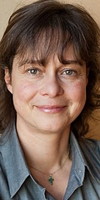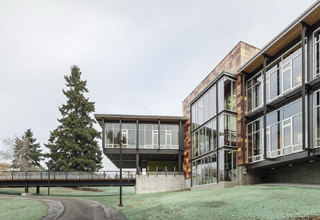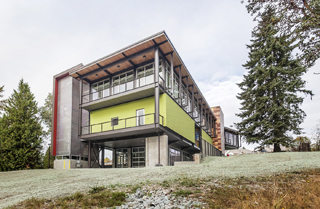|
Subscribe / Renew |
|
|
Contact Us |
|
| ► Subscribe to our Free Weekly Newsletter | |
| home | Welcome, sign in or click here to subscribe. | login |
Architecture & Engineering
| |
 |
October 25, 2012
TAF building is a calm respite among the trees
The Miller Hull Partnership

Kreiser
|
At a time when economic spirits are low and community needs are great, an inspiring design project for a progressive educational organization demonstrates it is possible to persevere and create a motivating environment serving both its users and community neighbors.
That project is the Bethaday Community Learning Center in White Center, the new headquarters of the Technology Access Foundation.
The learning center is a mixed-use facility with office space for TAF staff, classrooms for after-school programs and space for community events. It is an unusual building for a remarkable organization: starting with the development partnership and collaborative selection of the site, and continuing with the dedicated repurposing of salvaged materials, the home-grown nonprofit exemplifies its engagement with the community through its new building.
In 2005, TAF was a small nonprofit with a powerful mission and an impressive program to provide computer, science and technology education to students of color in underserved neighborhoods. The success of TAF’s programs was apparent, and growth was planned and inevitable.
Seven years ago a team assembled, ideas sprouted and plans emerged for a new facility that would accommodate this expansion.
Through a partnership with King County Parks & Recreation Department, TAF was offered a site in the underutilized Lakewood Park in White Center.
The partnership was a natural fit, according to Butch Lovelace of the Parks & Recreation: “For King County Parks, this project exemplifies the types of valuable community assets that can result from public-private partnerships and furthers King County’s equity and social justice goals.”
Lakewood Park is close to five schools and a new King County Housing project that is under construction. TAF promises to bring life to and eyes on the park: after school classes will host kids five days a week, and the building includes a community room on the ground level.
Crossing the bridge
The location in Lakewood Park was ideal for the new facility and the design team immediately recognized the tremendous potential of the site.
Placing a building within a public park came with considerable responsibility and required care and sensitivity. Local architect Miller Hull joined forces with San Francisco-based Public Architecture to generate a design concept that fit seamlessly within the natural landscape. Nestled into a knoll and threaded between the tall Douglas firs and madrones, the building is purposely set apart from the parking lot, connected by a bridge made of reclaimed wood.
“The bridge is the heart of the design concept,” says Craig Curtis, the design partner for Miller Hull. “When kids cross that bridge from the asphalt of the parking lot, across the salvaged wood beams and into the glass and steel pavilion in the trees, they enter a different world.”
Floating above the ground and connected only by the bridge, their new place of study becomes a calm respite among the trees.
The magnificent trees of the park become active participants in the building’s spaces through extensive glazing. Double-glazed, thermally broken storefront frames are set in an exposed steel framework. The clarity of the modern architecture is intended to represent the forward-thinking attitude of technology and science education.
Salvaged materials
One of the priorities that TAF brought to the design table was the desire to use salvaged materials. TAF founding partner Trish Millines Dziko was inspired by the “ScrapHouse,” an exhibit structure designed and built by Public Architecture. The “ScrapHouse” was a temporary demonstration home made entirely of salvaged materials including phone books and car windshields.
The use of salvaged materials in a permanent commercial building was quite different: Materials had to be considered for their long-term suitability, reviewed for potential toxic content, and evaluated for energy-efficiency and code compliance.
Public Architecture assisted the design team with the research and sourcing of appropriate salvaged materials for the TAF project. King County Parks and Recreation offered recovery missions to its surplus yards, and the King County Housing Authority invited the team to reclaim materials from housing projects slated for demolition.
The results are visible everywhere in and around the building, sometimes obvious, and sometimes you wouldn’t know the material is second-hand. King County road signs have been used as a lively exterior cladding, former King County Housing floor beams form the entry bridge, and a mosaic of colorful wood panels (cut-offs donated by Northshore Sheet Metal) wraps the circulation core.
Inside, solid-core doors from the King County Housing project have been applied as a wall finish, and were also used to build desks for TAF staff. Metro transit users will recognize the decorative glass from bus stops that will be transformed into a sliding glass door.

The process of incorporating salvaged materials in the design had its challenges. Early in the design phase, as opportunity and inspiration struck, materials were procured and had to be stored until construction started. This included the reclaimed timbers and the wood doors from the King County Housing development.
At times the team had to turn away materials that simply did not fit the need or the design, such as miscellaneous cabinetry and used carpet tile. In some cases it was easy, such as using new towel dispensers and light fixtures that had been rejected at another project.
With these materials the use fit the salvaged item, though frequently the team chose to assign a new career to an old material, such as the fan belts donated by Valley Medical Center on the board room wall. Their purpose now is expressly acoustic, yet their organic installation reflects their former purpose to rotate and grasp.
In many instances material placeholders were created and material selection occurred as needed or as available. This required creative adjustments and contractor cooperation at the last minute. A good example is the road signs offered by King County. The ease of installation made up for the detail revisions required to incorporate the signs late in the construction sequence.
One important roadblock to consider when repurposing salvaged materials is the code acceptability of the material. The team had planned to use fire hose as an alternative wall finish but could not, ironically, pass muster with the fire marshal.
The reuse of materials was a creative challenge that brought everyone together. Using salvaged materials has a sustainable side: less waste, less demand for raw resources, and lower transportation costs due to local sources.
The creative use of salvaged materials in unexpected ways can also add intrigue and spark to a project, and it can definitely be a conversation starter. However, there may be obstacles to overcome: Some reworking of the material may be required, and additional labor as well as storage may prove costly. Flexibility and collaboration by both designers and contractors is imperative.
While there may be some hurdles associated with the use of salvaged material, the incorporation of locally collected components together with the animation of a neglected green space showcases how a carefully considered building is connected to the community it serves. Reuse is just one way this project demonstrates how imagination and purpose can come together to express the spirited vision of a progressive organization.
Caroline Kreiser is a project manager at the Miller Hull Partnership.
Other Stories:
- Consulting engineers change the playbook as prime consultants
- Survey: Baylis Architects
- Survey: Lance Mueller and Associates
- Survey: NAC Architecture
- Survey: Cary Kopczynski & Co.
- Survey: Swenson Say Faget
- Survey: Weber Thompson
- Survey: MulvannyG2 Architecture
- Architects get creative to meet green expectations
- Economic downturn doesn’t slow sustainability
- Seattle’s climate puts a chill into data centers
- Sustainable living doesn’t have to be expensive
- Early flood warning gets a boost from technology
- Retailers mix it up; architects adjust
- How strong is your building’s public safety radio signal?
- Survey: Rice Fergus Miller Architecture & Planning




